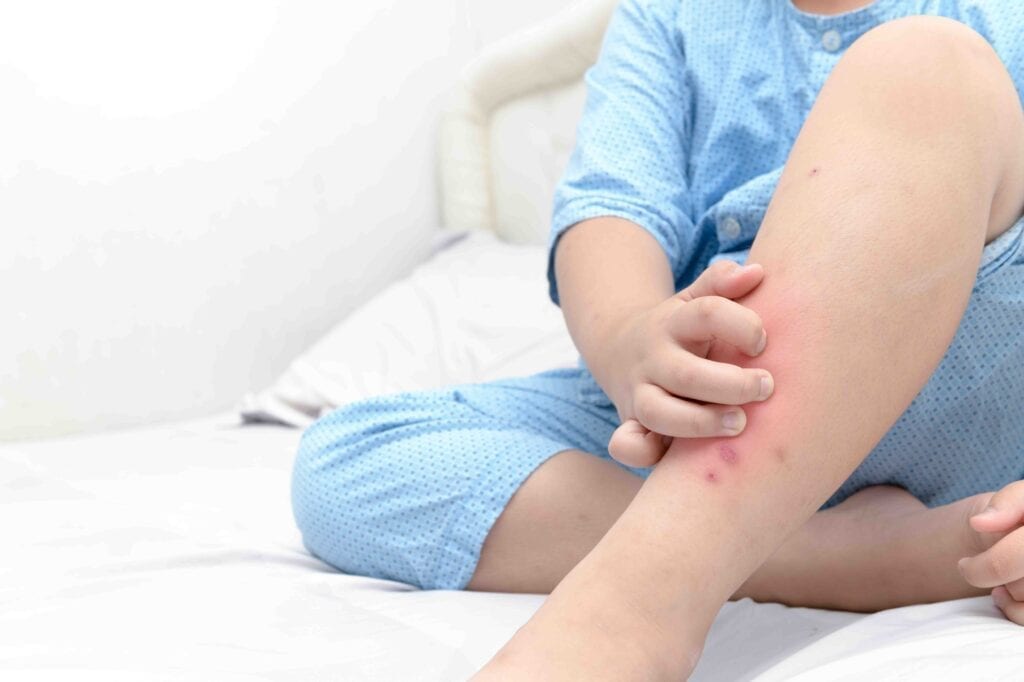Everyone is familiar with the fact that bed bugs create big discomfort and can be a huge challenge to get rid of
bed bug control in Overland Park. However, what may be a big surprise is that bedbugs can also survive outside in common public places like parks and school fields. They don’t have a very long survival rate outside, but it is long enough to get inside a home.
Bed bugs are parasites, plain and simple. So, they need to be in proximity to the food source to survive. They will travel and seek a source as much as possible, which is why they are so frequently found in homes versus any outside facility or structure.
Outside, the lawn is probably the safest place from bedbugs. They can’t function or survive in the plant blades and thickness. And they also can’t migrate from the lawn to the home and back again like ticks or fleas. However, the patio and particularly outdoor furniture and their cushions are another matter. On these surfaces, bedbugs can hide and wait until they can latch on to a host, be it a pet or a person. Some of the most suspect surfaces include rattan-style chairs and lounges, regular patio furniture with cushions, and even a dry dog bed or matt will do. Again, the whole strategy of the bedbug is to get to a viable host as much as possible. Once done, the bedbug can get inside the home and potentially settle in for a long, host-sponsored meal and life.
 Do bedbugs start outdoors?
Do bedbugs start outdoors?
Well, not really. The simple explanation is that the bedbugs were already infested in something like a mattress that was thrown out, and then they migrate to survive until another host is found. However, without securing food soon, the bedbug tends to be vulnerable. They don’t like moisture and prefer dry conditions as much as possible.
Some natural predators will easily attack and consume bedbugs. These predators include lizards, spiders, cockroaches, and even ants. They don’t wipe out bedbugs entirely, but when they do meet, the ending is pretty much certain.
Bedbugs are also not a good locomotive. Instead, they usually hitch a ride on something that can carry them far distances. That may be animals like a rodent, a larger pet or human unaware of what he or she just walked through. On their own, their distance radius is about 20 feet maximum. But that might be just enough to get into a home. And once they are in, they can be extremely hard to get rid of with plenty of hosts available to work and get cozy with. That said, most infestations happen through clothing, bags, containers, and cloth materials they can latch onto.
Interestingly, heat is a major problem for bedbugs. Heating a room is an effective way of removing an infestation inside the home; the heat outside has the same effect and will kill them. Once the outside temperature gets over 40 degrees Celsius, things get hard for the bedbug to continue. 50 degrees is the ideal killing temperature, which is unlikely outside, but the heat without a host everything wipes out most of them in the long-term.
Remember, bedbugs staying put in a dry location can bedbugs survive for up to four months without food. And, when things are very cold, the same can survive up to a year due to a much slower metabolic cycle. Eventually,
bedbugs will die off, but the amount of time they have before that creates a large window of possibility to find a host.
 Here are a few tips to cut down on the possibility of outside bed bugs hitching a ride into your home:
Here are a few tips to cut down on the possibility of outside bed bugs hitching a ride into your home:
● If you have traveled, leave the bags and clothes outside or at least in the garage for 24 hours as prevention.
● Take your traveling clothes and wash them immediately. Don’t let them sit around in the house.
● Don’t take any second-hand furniture unless you are sure it’s 100% clean.
● Anything that is infested needs to be treated. Don’t just chuck it in the garbage as-is or you could get reinvested later on as the bugs find their way back in.
● Immediately investigate anything that looks like an insect bite or tiny blisters. Little red or black spots or your bed linens are suspect too. All are signs of bedbugs rooted in already.
In short, your backyard lawn is clean and bedbug-free. The patio furniture, on the other hand, might be a risk if they haven’t been cleaned or treated recently. Pay regular attention and a watchful eye, especially after a trip, and you’ll avoid buggy problems altogether.
 Do bedbugs start outdoors?
Well, not really. The simple explanation is that the bedbugs were already infested in something like a mattress that was thrown out, and then they migrate to survive until another host is found. However, without securing food soon, the bedbug tends to be vulnerable. They don’t like moisture and prefer dry conditions as much as possible.
Some natural predators will easily attack and consume bedbugs. These predators include lizards, spiders, cockroaches, and even ants. They don’t wipe out bedbugs entirely, but when they do meet, the ending is pretty much certain.
Bedbugs are also not a good locomotive. Instead, they usually hitch a ride on something that can carry them far distances. That may be animals like a rodent, a larger pet or human unaware of what he or she just walked through. On their own, their distance radius is about 20 feet maximum. But that might be just enough to get into a home. And once they are in, they can be extremely hard to get rid of with plenty of hosts available to work and get cozy with. That said, most infestations happen through clothing, bags, containers, and cloth materials they can latch onto.
Interestingly, heat is a major problem for bedbugs. Heating a room is an effective way of removing an infestation inside the home; the heat outside has the same effect and will kill them. Once the outside temperature gets over 40 degrees Celsius, things get hard for the bedbug to continue. 50 degrees is the ideal killing temperature, which is unlikely outside, but the heat without a host everything wipes out most of them in the long-term.
Remember, bedbugs staying put in a dry location can bedbugs survive for up to four months without food. And, when things are very cold, the same can survive up to a year due to a much slower metabolic cycle. Eventually, bedbugs will die off, but the amount of time they have before that creates a large window of possibility to find a host.
Do bedbugs start outdoors?
Well, not really. The simple explanation is that the bedbugs were already infested in something like a mattress that was thrown out, and then they migrate to survive until another host is found. However, without securing food soon, the bedbug tends to be vulnerable. They don’t like moisture and prefer dry conditions as much as possible.
Some natural predators will easily attack and consume bedbugs. These predators include lizards, spiders, cockroaches, and even ants. They don’t wipe out bedbugs entirely, but when they do meet, the ending is pretty much certain.
Bedbugs are also not a good locomotive. Instead, they usually hitch a ride on something that can carry them far distances. That may be animals like a rodent, a larger pet or human unaware of what he or she just walked through. On their own, their distance radius is about 20 feet maximum. But that might be just enough to get into a home. And once they are in, they can be extremely hard to get rid of with plenty of hosts available to work and get cozy with. That said, most infestations happen through clothing, bags, containers, and cloth materials they can latch onto.
Interestingly, heat is a major problem for bedbugs. Heating a room is an effective way of removing an infestation inside the home; the heat outside has the same effect and will kill them. Once the outside temperature gets over 40 degrees Celsius, things get hard for the bedbug to continue. 50 degrees is the ideal killing temperature, which is unlikely outside, but the heat without a host everything wipes out most of them in the long-term.
Remember, bedbugs staying put in a dry location can bedbugs survive for up to four months without food. And, when things are very cold, the same can survive up to a year due to a much slower metabolic cycle. Eventually, bedbugs will die off, but the amount of time they have before that creates a large window of possibility to find a host.
 Here are a few tips to cut down on the possibility of outside bed bugs hitching a ride into your home:
● If you have traveled, leave the bags and clothes outside or at least in the garage for 24 hours as prevention.
● Take your traveling clothes and wash them immediately. Don’t let them sit around in the house.
● Don’t take any second-hand furniture unless you are sure it’s 100% clean.
● Anything that is infested needs to be treated. Don’t just chuck it in the garbage as-is or you could get reinvested later on as the bugs find their way back in.
● Immediately investigate anything that looks like an insect bite or tiny blisters. Little red or black spots or your bed linens are suspect too. All are signs of bedbugs rooted in already.
In short, your backyard lawn is clean and bedbug-free. The patio furniture, on the other hand, might be a risk if they haven’t been cleaned or treated recently. Pay regular attention and a watchful eye, especially after a trip, and you’ll avoid buggy problems altogether.
Here are a few tips to cut down on the possibility of outside bed bugs hitching a ride into your home:
● If you have traveled, leave the bags and clothes outside or at least in the garage for 24 hours as prevention.
● Take your traveling clothes and wash them immediately. Don’t let them sit around in the house.
● Don’t take any second-hand furniture unless you are sure it’s 100% clean.
● Anything that is infested needs to be treated. Don’t just chuck it in the garbage as-is or you could get reinvested later on as the bugs find their way back in.
● Immediately investigate anything that looks like an insect bite or tiny blisters. Little red or black spots or your bed linens are suspect too. All are signs of bedbugs rooted in already.
In short, your backyard lawn is clean and bedbug-free. The patio furniture, on the other hand, might be a risk if they haven’t been cleaned or treated recently. Pay regular attention and a watchful eye, especially after a trip, and you’ll avoid buggy problems altogether.


















